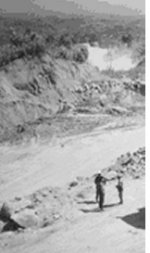Letter from Burma 5

By jeand
- 2563 reads
Heinda Mine
Tenasserim
Southern Burma
February 5, 1935
Dear Harold and Muriel,
You asked me to tell you how I was getting on with tin mining here, so I will do just
that. I hope you won't find it too boring. You probably know that the company I work for is the Anglo Burma Tin Company and the chairman is F.A. Robinson. We haven't been having such a good time of it lately, and a few years ago, we had to raise some cash. Luckily the Anglo-French sister company was willing to lend us £50,000 which imposed no obligation on the shareholders to subscribe. They accepted debentures for the whole amount, including interest. With that injection of capital, we were able to increase our production, which, however, due to the rains causing flooding in one of the mines, caused a temporary stoppage to a portion of the plant. Again, as you are no doubt aware, due to the depression, the price of tin has gone down, and there is no doubt we were struggling, but we managed, and things are starting to come good again.
What we needed was a more steady supply of water, so we were promised an auxiliary pipeline. The French sent their engineer, M. Frescheville, to discuss the matter with me, and he agreed that it was a reasonable way to help the situation and augment the water supply during the meager times. He was inclined to think that it would be economically
sound to do this, and as they were holding their own at the time, it seemed the right policy to spend a little more money to put their sister company on a firm foundation.
Yardage treated at Heinda was 721,605 last year as compared with 562,830 in the previous one. The total out put of tin ore was 450 tons as compared with 374 tons.
To work the hill ground and increase the output it would be necessary to construct another branch extension of the existing pipeline and to install a small power plant, to command the highest parts of the deposit, which prove to be also the richest. It is estimated that at and near the top of Hpolontaunt hill, there are 500,000 cubic yards averaging 2 1/2 lbs of tin ore per cubic yard.
As I probably told you before, our stream, the Packchan, is the richest in tin ores of all the districts of Tenassarim. It divides Burma from Siam. The range of mountains in which the ore is found is a continuation of the tin territory of Rinowyn in Siam. The tin is found in the debris of primitive rocks, but the grains or crystals sometimes are the size of a pigeon's egg and the soil yields 8-10 feet of tin; while at Tavoy the utmost is 7 feet. All land transport is avoided, by our predecessors establishing themselves on one of the smaller rivers falling into the Packchan.
There is also tungsten here in quantity, which we are not yet fully able to capitalize on. There is a bit of gold, as there is all over Burma, but not enough to get excited over - like we did when we were in Canada. Tin as a mineral (a dioxide), in the Mergui and Tavoy
districts of the valley, is extracted from the pebbles found in the river. Pebbles are collected and then washed; washing process yields 70% tin in the first washing and 75% in the second washing, and the ore thus extracted is very rich and metal produced from this is of excellent quality.
As far as this year goes, we are still having water supply problems, and flooding in
number 2 mine, so things are not completely better.
Our rivals - the Tavoy Tin company have also gone down the route of getting more
capital through debentures. There are really three kinds of tin mining here; dredging, which we do, sluicing, which they do near here at Kanbauk, and there is also an underground tin mine at Hermyingyi, under the Consolidated Tin Mines Ltd.
I hope that answers your questions.
Best wishes,
Your brother Mark
- Log in to post comments
Comments
It sounds like hard work.
It sounds like hard work. How little thought we tend to give to these hard won materials.
- Log in to post comments
Of course, Cornwall had a
Of course, Cornwall had a very important tin mining industry, didn't it, so that was why the college was there, I suppose. I thought that was what produced the white slag heaps, but I think that is from the china clay industry probably. Rhiannon
- Log in to post comments
Having visited Cornish tin
Having visited Cornish tin mines, I found this really interesting, Jean.
- Log in to post comments
I never realised tin was so
I never realised tin was so important, it must have been very rewarding to work the mines.
Another interesting read Jean.
Jenny.
- Log in to post comments


